Are you ready to uncover the astonishing appetites of the animal kingdom?
From hippos munching on nearly forty kilograms of food each day to blue whales devouring four tonnes of krill, these animals certainly know how to satisfy their hunger.
But, have you ever wondered which animal takes the crown for being the most voracious eater?
In this discussion, we will explore the diets and eating habits of various animals, from herbivores to carnivores, and delve into the intricate relationships between predators and prey.
Get ready to be amazed by the insatiable hunger of the animal world!
Hippos: Massive Food Consumption
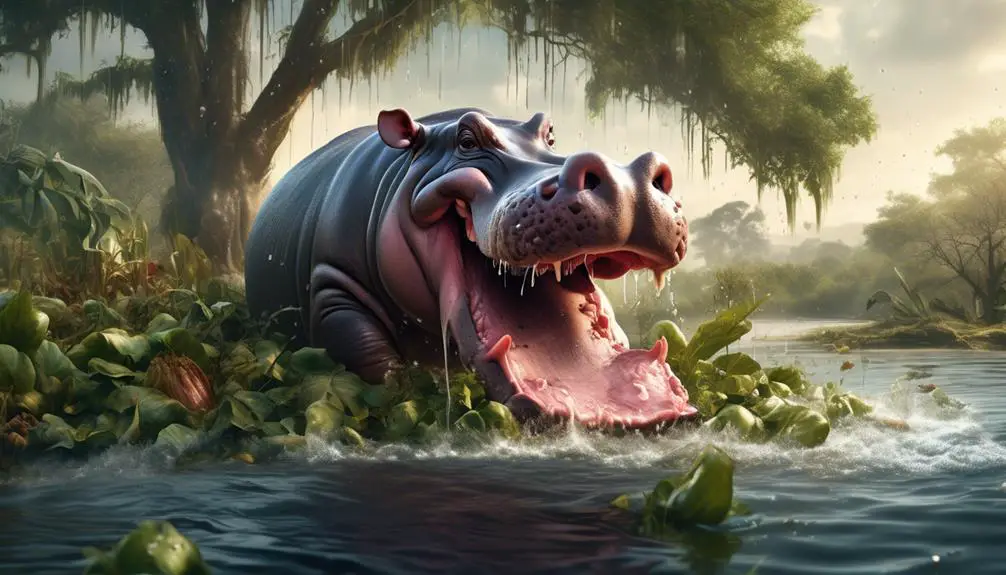
Hippos, known for their massive size and voracious appetite, consume an astonishing amount of food each day. These herbivorous animals have a diet consisting mainly of grass, which they consume in large quantities. On average, hippos consume nearly forty kilograms of food or grass each day.
Hippos are known to spend a significant portion of their day grazing. They’ve a unique feeding behavior where they walk along the riverbeds or banks, using their large mouths to grab and tear grass. They’ve strong jaws and sharp teeth that allow them to efficiently process and consume their food.
The reason behind this massive food consumption is the hippo’s high energy requirements. Despite their seemingly docile nature, hippos are actually quite active and require a substantial amount of energy to sustain their massive bodies. This constant need for energy drives their incessant grazing behavior.
In addition to their high food intake, hippos have a specialized digestive system that allows them to efficiently extract nutrients from their food. Their large stomachs and complex fermentation chambers enable them to break down tough plant material and extract the necessary nutrients.
Understanding the dietary habits of hippos isn’t only fascinating but also essential for their conservation and management. By studying their feeding behavior and food requirements, we can better understand their ecological role and the impact of habitat changes on their populations.
African Elephants: Incredible Eating Habits
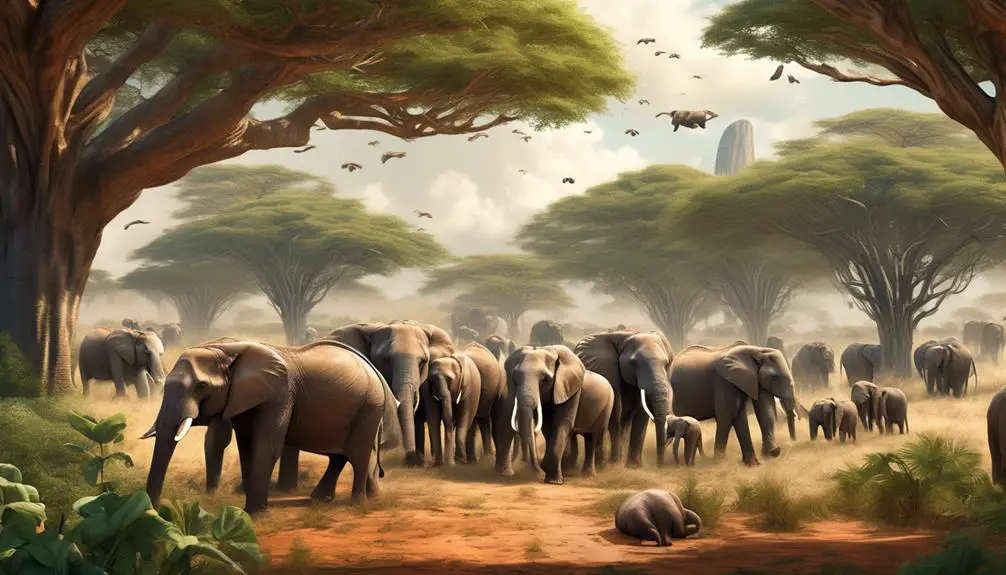
African elephants possess incredible eating habits that are truly impressive. These majestic creatures can consume a staggering amount of food, with each individual consuming nearly three hundred pounds of food on a daily basis.
Their ability to consume such a large quantity of food showcases their remarkable eating abilities and highlights their importance in maintaining the balance of ecosystems.
Elephant Food Consumption
With an insatiable appetite, African elephants astound with their incredible food consumption. These magnificent creatures are herbivores, feeding primarily on grasses, leaves, bark, and fruits. They require a massive amount of food to sustain their enormous size and energy needs.
On average, an adult African elephant can consume up to 300 pounds of food in a single day. This astonishing intake is necessary to fuel their massive bodies, which can weigh up to 12,000 pounds. African elephants use their strong trunk to gather food and bring it to their mouths, ensuring efficient consumption.
Their ability to consume such a vast quantity of food highlights their vital role in shaping their ecosystems as they disperse seeds through their dung, contributing to the regeneration of plant life.
Impressive Eating Abilities
The remarkable eating abilities of African elephants captivate researchers and wildlife enthusiasts alike. These majestic creatures possess an incredible capacity for consuming vast amounts of food. With an average daily intake of nearly three hundred pounds, African elephants are among the most voracious eaters in the animal kingdom.
Their diet primarily consists of grasses, leaves, bark, and fruits, which they consume in large quantities to meet their energy requirements. This impressive eating habit is necessary to sustain their massive size and maintain their physical strength. Furthermore, their ability to efficiently process and digest vegetation allows them to extract maximum nutrients from their food sources.
Studying the eating habits of African elephants provides valuable insights into their ecological role as primary consumers and highlights the unique adaptations that enable them to thrive in their natural habitats.
Blue Whales: Voracious Krill Consumers
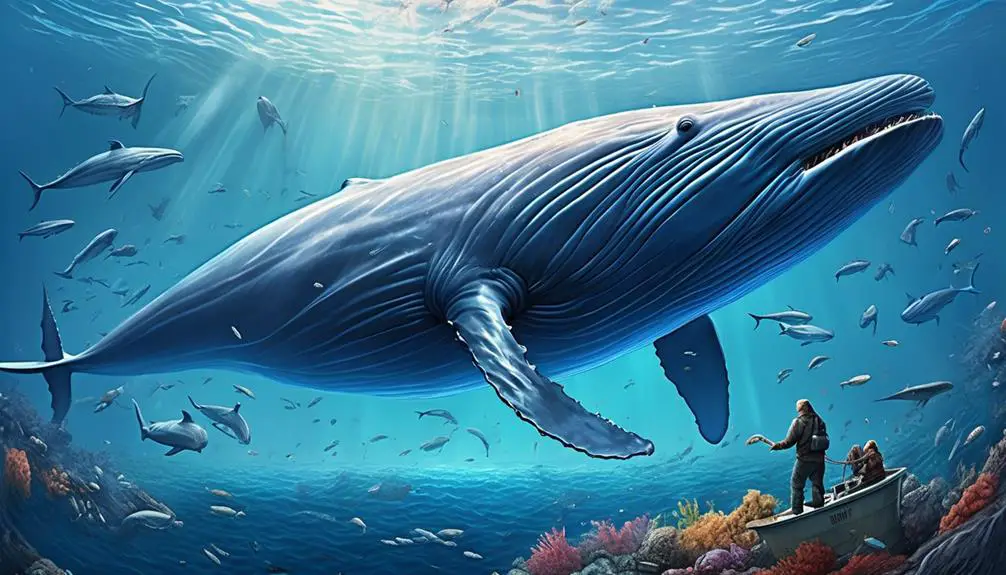
Blue whales, the largest animals on Earth, demonstrate a voracious appetite as they consume an astounding four tonnes of krill every day. These magnificent creatures rely heavily on krill as their primary food source, exhibiting a remarkable feeding strategy that allows them to sustain their massive size.
Blue whales are filter feeders, using baleen plates in their mouths to trap and filter large quantities of water filled with tiny krill. They employ a technique known as lunge feeding, where they accelerate towards a dense patch of krill, opening their mouths wide, engulfing both water and prey. The water is then expelled through the baleen plates, while the krill remain trapped, ready to be swallowed.
To consume four tonnes of krill daily, blue whales must feed continuously for several hours. This requires them to locate dense concentrations of krill, which can be found in cold, nutrient-rich waters. By tracking the seasonal movement of krill populations, blue whales are able to optimize their feeding efficiency.
Their ability to consume such vast quantities of krill highlights the important role they play in maintaining the balance of marine ecosystems. As primary consumers, blue whales contribute to the transfer of energy from the microscopic krill to higher trophic levels, sustaining the overall productivity of the ocean.
Understanding the feeding habits of blue whales is crucial for their conservation. As human activities continue to impact the availability of krill and disrupt their habitats, it’s essential to protect these magnificent creatures and ensure the preservation of their food sources.
Pigs: Surprising Carbohydrate Intake
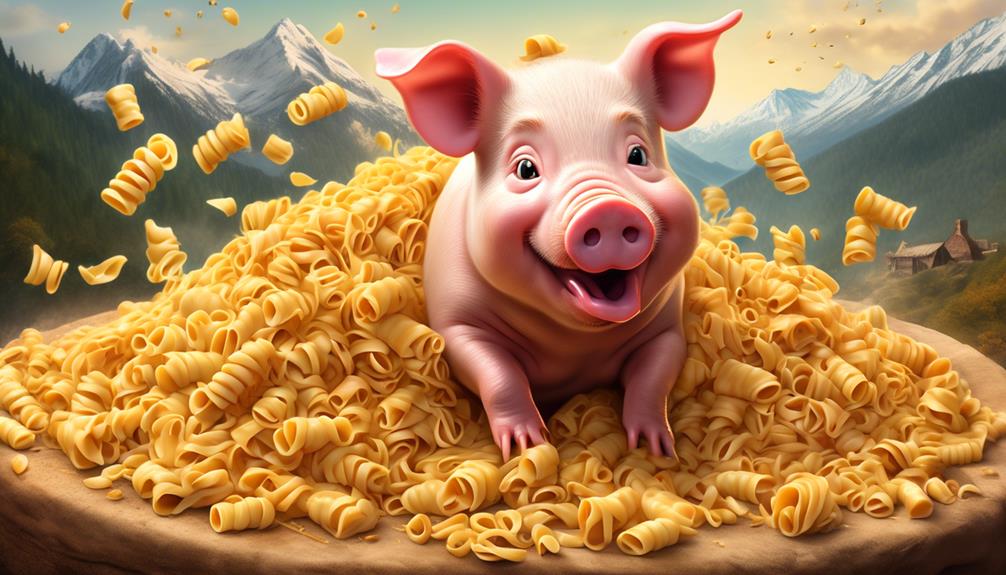
Pigs exhibit a surprisingly high intake of carbohydrates compared to humans. While humans typically consume carbohydrates in the form of grains, fruits, and vegetables, pigs have a unique ability to digest and utilize carbohydrates from a variety of sources. Their digestive system is adapted to efficiently break down complex carbohydrates into simpler sugars, which can be readily absorbed and used for energy.
One reason for their high carbohydrate intake is their natural omnivorous diet. Pigs are known to consume a wide range of foods, including fruits, vegetables, grains, and even roots. This diverse diet allows them to obtain a significant amount of carbohydrates from different sources. Additionally, their digestive system has a large capacity to ferment carbohydrates, further enhancing their ability to extract energy from these foods.
Furthermore, pigs have a high metabolic rate and energy requirements due to their active lifestyle. They spend a considerable amount of time rooting and foraging for food, which requires a lot of energy. Carbohydrates serve as a readily available source of energy, allowing pigs to sustain their activity levels and meet their physiological needs.
Sharks: Impressive Daily Feeding
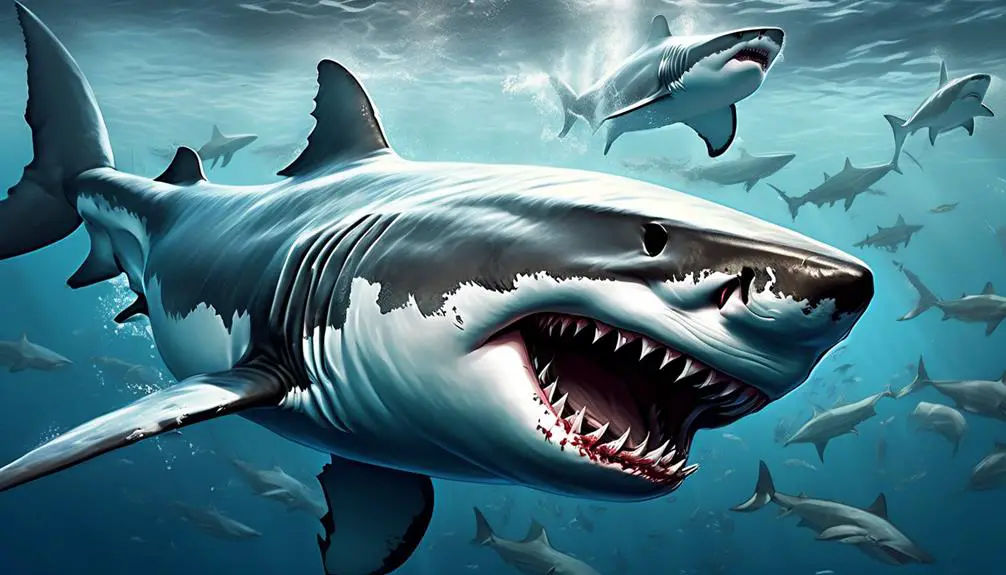
With their remarkable feeding habits, sharks demonstrate an impressive ability to consume a substantial amount of food on a daily basis. Sharks are apex predators, occupying the top of the marine food chain. They have evolved to be efficient hunters, with a keen sense of smell and excellent vision. Their diet consists mainly of fish, seals, sea lions, and other marine mammals.
To give you a better understanding of their daily feeding habits, here is a table illustrating the approximate amount of food consumed by different shark species:
| Shark Species | Average Daily Food Consumption |
|---|---|
| Great White Shark | 30 kilograms |
| Tiger Shark | 20 kilograms |
| Hammerhead Shark | 15 kilograms |
It is important to note that these figures are averages and can vary depending on factors such as the size and metabolism of the shark. Sharks have a high energy requirement due to their active lifestyle, and their daily feeding allows them to maintain their energy levels and survive in their marine environment.
Bears: High Food Requirements
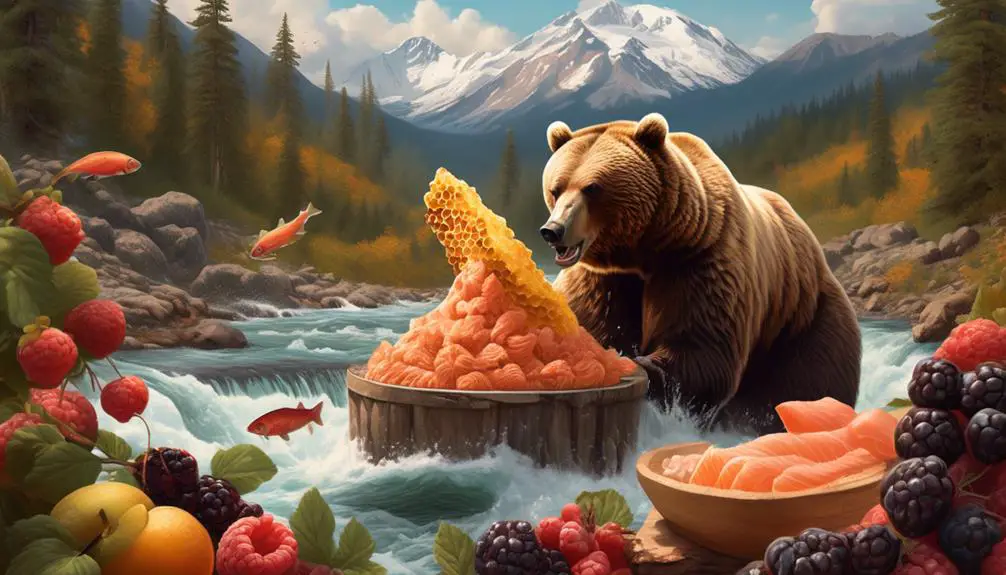
Bears, known for their impressive size and strength, have notably high food requirements to sustain their energy levels and support their survival in the wild. These large mammals are classified as omnivores, meaning they have a diverse diet that includes both plants and meat. Bears have a unique ability to digest a wide variety of food, including fruits, nuts, insects, fish, and even larger mammals. This adaptability allows them to take advantage of available food sources in their habitat.
The high food requirements of bears can be attributed to several factors. Firstly, their large body size necessitates a substantial intake of calories to maintain their weight. Additionally, bears have a relatively low metabolic rate, which means they require a greater amount of food to meet their energy needs. This is especially important during periods of high activity, such as during the mating season or when preparing for hibernation.
Bears also possess a specialized digestive system that enables them to extract maximum nutrients from their food. Their digestive tract is designed to break down tough plant material and efficiently absorb nutrients. This allows bears to extract the necessary energy from their food, even when resources are scarce.
Giraffes: Constant Leaf Consumption

Giraffes, renowned for their towering height and graceful presence, exhibit a fascinating feeding behavior characterized by constant leaf consumption. As herbivores, these majestic creatures rely on leaves as their primary source of nutrition. Their long necks allow them to reach high into the trees, where they can access the freshest and most nutritious leaves. This constant leaf consumption is necessary for their survival, as leaves provide the essential nutrients, such as proteins and minerals, that giraffes need to thrive.
Giraffes have evolved unique adaptations to support their constant leaf consumption. Their prehensile tongues, measuring up to 18 inches in length, are perfectly adapted for grasping and stripping leaves from branches. Additionally, their saliva contains antifungal and antibacterial properties, which protect them from ingesting harmful microorganisms present on the leaves.
Observations have shown that giraffes spend a significant portion of their day feeding, with adult giraffes consuming an average of 34 kilograms of leaves daily. This high intake is necessary to meet their energy demands and maintain their large body size. By constantly browsing on leaves, giraffes have developed a specialized digestive system that efficiently breaks down and absorbs nutrients from their food.
Human Food Consumption and Impact
Humans have a significant global food consumption, which has a substantial environmental impact. The production and distribution systems that support our diverse dietary preferences play a crucial role in feeding the global population.
However, overconsumption of certain foods can lead to health issues, and human activities can disrupt natural food chains, impacting wildlife populations.
It’s essential to promote sustainable farming practices to ensure a healthier and more environmentally friendly food system.
Global Food Consumption
Global food consumption has a significant impact on the environment and human health. As the global population continues to grow, the demand for food increases, leading to various consequences.
The production and distribution of food contribute to greenhouse gas emissions, deforestation, and water pollution. Additionally, unhealthy food choices and overconsumption can result in obesity, cardiovascular diseases, and other health issues.
The current food system isn’t sustainable, and it’s crucial to address these challenges. Sustainable farming practices, such as organic farming and agroforestry, can help reduce the environmental impact of food production.
Furthermore, promoting a balanced and nutritious diet can improve human health. It’s important to consider the ecological and health implications of our food choices to create a more sustainable and healthier future.
Environmental Impact
The impact of human food consumption on the environment is a significant concern due to its contribution to greenhouse gas emissions, deforestation, and water pollution.
The production and transportation of food contribute to the release of greenhouse gases, such as carbon dioxide and methane, which contribute to climate change.
Additionally, the expansion of agriculture leads to deforestation, as forests are cleared to make way for croplands and livestock grazing. This deforestation not only reduces biodiversity but also removes important carbon sinks.
Furthermore, the use of fertilizers and pesticides in agriculture can contaminate water sources, leading to water pollution and harm to aquatic ecosystems.
It’s crucial to adopt sustainable farming practices, reduce food waste, and promote a more environmentally friendly food system to mitigate these negative environmental impacts.

Erzsebet Frey (Eli Frey) is an ecologist and online entrepreneur with a Master of Science in Ecology from the University of Belgrade. Originally from Serbia, she has lived in Sri Lanka since 2017. Eli has worked internationally in countries like Oman, Brazil, Germany, and Sri Lanka. In 2018, she expanded into SEO and blogging, completing courses from UC Davis and Edinburgh. Eli has founded multiple websites focused on biology, ecology, environmental science, sustainable and simple living, and outdoor activities. She enjoys creating nature and simple living videos on YouTube and participates in speleology, diving, and hiking.
- WILDLIFE THEMED T-SHIRTS
Cute Hedgehog Embroidered: Love Wildlife, Protect Nature Wildlife conservation tees
$35.00







